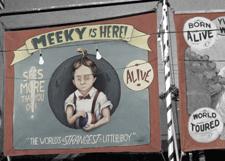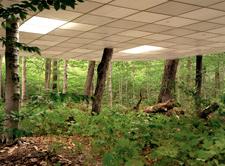
MEEKY. University and Grosvenor.

HORRIDOR. In Union Station.
The wild success of Nuit Blanche two years ago took almost everyone by surprise. It was something new and exciting, which is rare enough in this city, and perhaps for that reason anyone and everyone was willing and eager to participate. I remember walking around Queen West in that inaugural year, amused, perplexed and thrilled that the streets were not only chock-a-block with people, but all kinds of people: the usual skinny-jeans-and-floppy-hair art kids (were skinny jeans in yet in 2006? Well, you know what I mean), old folks out for an art stroll, the young-professional condo crowd, families of four. Turns out Torontonians are just aching for an excuse to spend all night looking at art installations.
Why these same people felt that going to an art gallery any other day of the week during daylight hours was too much, I couldn’t tell you. Still, it really did feel like a little bit of magic; the late fall air was crisp, everyone was excited by this new thing, I was excited to see unfamiliar faces at what was basically an art opening and it was possibly the most utopic I’ve ever felt at an art event.
Nuit Blanche isn’t new anymore, and after some vague complaints about the organization and corporatization of last year’s edition, the autumn air isn’t exactly wafting utopia anymore. Still, Nuit Blanche is about as revealing and accessible as public art events get. There’s no admission fee, and it offers up a side of our city that most people never see — how many people regularly linger in the alleyway next to St Enoch’s Square at 4am, let alone know where St Enoch’s Square even is? For that matter when was the last time you and your friends went out into the city just to roam and discover?
The art itself might be a bit touch-and-go but, in a city socially organized around scenes and cliques, it’s still a pretty amazing moment of integration between the city and its artists. Given the general accessibility of the work, and the diversity of the viewers, it’s also the most visible display of Toronto’s art community to happen all year and, what’s more, with the Toronto International Art Fair going at the same time, it’s an event that has nothing to do buying or selling.
How to work it
First, practicalities: jacket, comfy walking shoes and cash just in case you need a taxi and it’s 4:45am and your enthusiasm for installation art isn’t as strong as you thought and it’s cold and you just want to get to bed already! Your choice of all-night stimulant is up to you (I, personally, being a bit of a cocktail queen, enjoy coffee, cream and Kahlua).
The work is arranged in three zones, and each contains a curated exhibition, independent projects and participating galleries. Zone A is the largest, running from Bloor St down to Queen, between Jarvis and Spadina and includes the Church/Wellesley village. Zone B is immediately south of that, from Queen down to the Lakeshore, with the same east-west boundaries as Zone A. Zone C encompasses West Queen West and Liberty Village, running along Queen and King streets, west of Bathurst until Roncesvalles. If you try and do everything in 12 hours, more power to you, but I am willing to risk a libel lawsuit to state, officially and in print, that you’re crazy.
Which brings me to the most important part of working Nuit Blanche: Figuring out what you want from it. Decide if you want to spend the night engaging in visually demanding and theoretically abstract art or if you want a more easygoing 12 hours. Would you rather look at objects, or be engaged by performances?
Curator Gordon Hatt has taken the mission statement of Nuit Blanche — transforming the city through art — and translates it fairly literally into his curated works in Zone A. The art here is mostly installation-based and is all about the New World. Artists are invited to respond to the city’s public spaces and surfaces as a medium unto themselves.
Be sure to swing by the aforementioned St Enoch’s Square alleyway (it’s next to Massey Hall), where Quebec-based art prankster collective BGL recreate 2005 Domain de L’Angle installation. The trio installs a 40-foot-long office ceiling, complete with fluorescent lights and fibreboard tiles.
In the Church/Wellesley village Diaspora Dialogues sees John Gzowski and Camellia Koo asking people, “Where are you right now?” throughout the night, mixing the recorded responses into an ever-evolving sound installation at the National Ballet School. Along the main drag on Church from Wellesley to Gloucester the Toronto Nightless Collective will perform Molly Wood’s Bush, a recreation of the forest once belonging to 19th-century nelly Alexander Wood — think people pretending to be trees and you’re on the right track. Whether or not you can engage in park sex depends on the comfort level of the individual tree you’re grinding against, I guess. And just around the corner Luis Jacob has all of Maple Leaf Gardens to play with, where he’s showing his new multimedia installation Without Persons. Two digital voices (one male, one female) pontificate on the meaning of living in a city in the constant press of buildings and people. A video projection accompanies and illustrates the narration.
At Xerioscape (corner of University and Grosvenor) Roy Kohn channels some carny freakishness for his installation Meeky: The World’s Strangest Little Boy 2004-2008, a fabricated faux-sideshow exposition of the life of eponymous Meeky, complete with waxworks figures and dioramas.
Zone B seems the most promising. Curator Wayne Baerwaldt aims to capitalize on the interactive aspects of Nuit Blanche’s art Easter egg hunt. He seeks to engage viewers with performances and performance-based installations that, according to his curatorial statement, “will skewer audience expectations by blurring the lines between artist/performer and audience member.”
For his installation entitled Benefit of the Doubt, Barr Gilmore creates a to-scale replica of the “honest” part of Honest Ed’s iconic and eye-searing signage, installing it in the courtyard behind the York County Courthouse (Adelaide and Church). For her Horridor, Kelly Mark lines the lower west entrance of Union Station with TVs showing snippets of horror movies on perpetual loop. For those not content with being spectators Farah Yusuf and Alex Stephan offer R U Part of the Art?, wherein they send willing participants cell phone text messages containing instructions for public performances. Enrollment for this project is limited so if this tickles your fancy find out more at Derivativeinc.com/rupartoftheart.
Zone C has two curators: Haema Sivanesan takes over Liberty Village with heavily politicized talk of societies at crossroads and social dystopias and Dave Dyment offers something a little more optimistic for West Queen West entitled Beginning to See the Light, focusing on hope, expectation and epiphany.
Yoko Ono installs her “Imagine Peace” billboard (which is exactly what it sounds like) at the corner of Liberty and Jefferson. You can also take home an “Imagine Peace” button — 40,000 of them will be distributed at the site. If glib, namby-pamby, irrelevant responses to global conflict aren’t your bag, indulge your destructive side at Smash! (in the parking lot behind 60 Atlantic Ave) where the Custodians of Destruction will, over the course of the night, introduce an object and then ceremonially destroy it.
Andrew Harwood performs as Madame Zsa Zsa the Underwater Oracle at the Social (Queen and Dovercourt) and a little further down the road at the Wrong Bar 10 emerging fashion designers put on The Art of Fashion: Between the Lines. A grand total of 60 outfits sashay around and spectators can pick their favourite designer.
This is, to make a huge understatement, only a partial list. The entire rundown of the night with full descriptions and photos can be found at Scotiabanknuitblanche.ca. So make your own list, draw your own map, top up your thermos with the liquor of your choice and embark on an all-nighter out on the town.

 Why you can trust Xtra
Why you can trust Xtra


